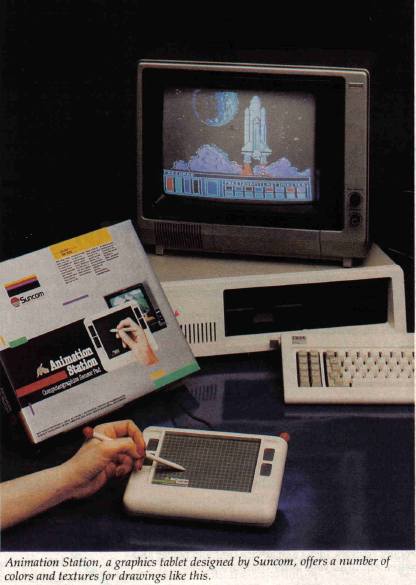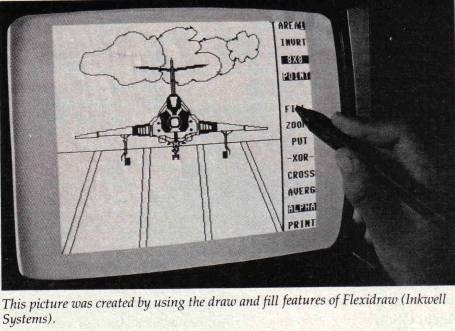Light Pens And Graphics Tablets: New Ways to Communicate With Your Computer
by Kathy Yakal, Editorial Assistant
You don't have to be an artist to use them. Or a three-year-old. Or a professional architect, engineer, or fabric designer. Light pens and graphics tablets, along with the software that drives them, are making computing easier for young children and adding new dimensions in graphics for everyone.
Whether or not we admit it, we've probably all responded to our computer's SYNTAX ERROR message by typing "Syntax error? I typed it right!"
We may have jabbed a finger at the monitor to show our word processing program precisely which block of text we wanted moved and where we wanted it placed. Or maybe drawn a picture of a spaceship and held it up to the screen to illustrate exactly what we wanted displayed there after typing in a machine language game for the better part of a weekend.
The computer never seems to understand.
Interacting with a microcomputer can sometimes prove exasperating. You still have to talk to a computer in a language it understands. They don't yet respond to written or spoken English.

A Pointer To The Future
But graphics tablets and light pens bring us a step closer to easy communication by allowing information entry to bypass the keyboard. Like mice and joysticks and the keyboard itself, light pens and graphics tablets are input devices, peripherals through which you interact with your computer.
These pens and tablets do basically two things: draw and point. You can use them to select user options in menu-driven software and to create graphics.
A light pen is like a magic wand. It resembles a regular pen in size and shape, and has a cord that plugs into the computer. When you point it at the screen and activate it (either by pressing a switch on the pen itself or a key on the keyboard), it responds to whatever software you're running.
Touch-Sensitive Input
A graphics tablet looks a little like an Etch-A-Sketch, though each manufacturer's is a little different. Instead of pointing at the computer screen, you touch the surface of the tablet with your finger or a stylus.
Though light pens and graphics tablets are fairly new on the home computer scene, they've been used as design tools with larger computers for years. The technology is not brand-new.
Where's The Software?
The Edumate Light Pen, from Futurehouse, Inc., comes with introductory software that demonstrates the pen's features. If that's where it ended, the skeptics' claims that these tools are just gimmicks might be true.
But Futurehouse, along with other light pen manufacturers and software publishers, is beginning to design software that can be used with a light pen. "The potential applications are enormous," says Byrne Elliot, president of Inkwell Systems, another pen manufacturer.
"Not just being able to point at a menu option you might want. They'd be great with even things like spreadsheets and word processors. Instead of learning a lot of control commands that can be very frustrating, you can move text and figures around quickly and easily."
Doing What Comes Naturally
If you've ever tried using spray paint to letter a sign or illustrate a big banner, you have an idea of what drawing with a light pen feels like. The stream of color sometimes comes out faster than you can control it.
Drawing on a graphics tablet is not quite so novel a technique to master. It's like drawing on a piece of paper with a pencil, or drawing pictures on a steamy windowpane with your finger. Using these pens or tablets is, however, intuitive, to a degree. "Among the first skills that everyone learns when they're young is drawing or writing," says Howard Leventhal, president of Suncom, manufacturers of Animation Station. "There are no other input devices that let someone do that in such a friendly way."
This may be why these new input devices are being so highly touted as educational tools. "There's a strong motivation for people to buy for educational purposes," says Leventhal.
Like Being A Kid Again
It's not hard to see why graphics tablets and light pens can open the world of computing for children. These peripherals don't require the hand-eye coordination or knowledge of letters and numbers that a keyboard does.
"Light pens are superb for education. They really expedite the learning process," says Elliot. "They're a good way to get around the intimidation of the keyboard. To respond to software using a keyboard, you have to type in a series of letters and numbers, then return. The light pen is generally 10-15 times faster than that."
Bob Ranson, president of Chalkboard, agrees. "Graphics tablets allow the preliterate child to use a computer without having to deal with a keyboard," he says. "There are lots of two- and threee-year-olds using them."
Beyond that, graphics tablets and light pens can attract adults as well. "People seem to enjoy being able to sit down and draw," says Ranson. "Graphics tablets meet a fundamental human need—the need to express oneself."
Light Pen Elbow?
The naysayers to these new communication tools complain about physical inconveniences. Your arm can get tired from holding the light pen. The cord can get tangled and caught under things. It can be confusing to look back and forth from the tablet to the screen.
"There is a spatial problem when you're writing or drawing on the screen," says Ranson. "But I don't think it's major." Elliot argues that "Once familiarity sets in, you don't look at the tablet."
A more serious accusation is that they're kids' stuff, that you can't do more than draw pictures of trees and bunnies and houses.
"Granted, they're great for kids," says Byrne Elliot. "I know a lot of kids use Flexidraw for things like making valentines. But I also know of women who use it to design wallpaper and make dress patterns, and professionals who draw up plans for the interiors and exteriors of buildings with it. Graphics is becoming a lot more important to different kinds of people."

Input For The Future
Will a new input device come along that will make pens and tablets or, for that matter, keyboards obsolete? "Voice recognition is not as simple as some people think," says Chalkboard's Ranson. "Say you're a writer and want to sit down and dictate your work. I defy you to read everything you write all day. You'll lose your voice.
"Until we've reached the ultimate, there will be a lot more people exploring how to get into the computer other than QWERTY. We've been existing with joysticks and keyboards for a long time now. There will always be room for more than one input device."